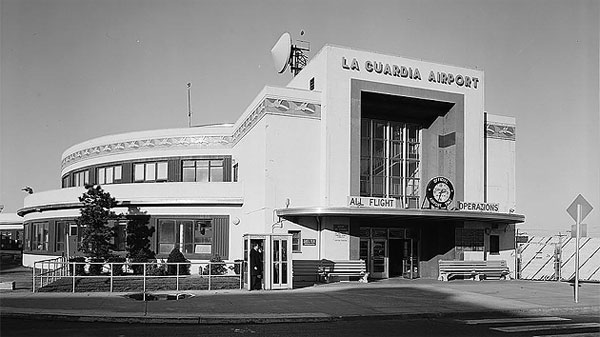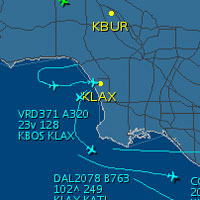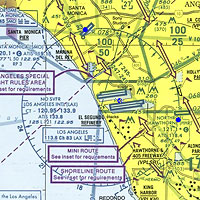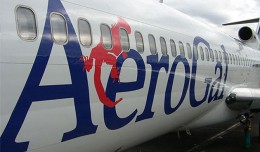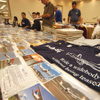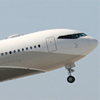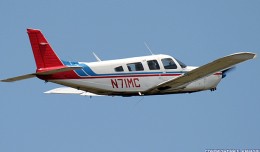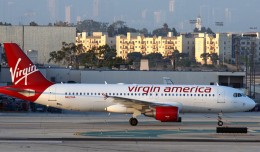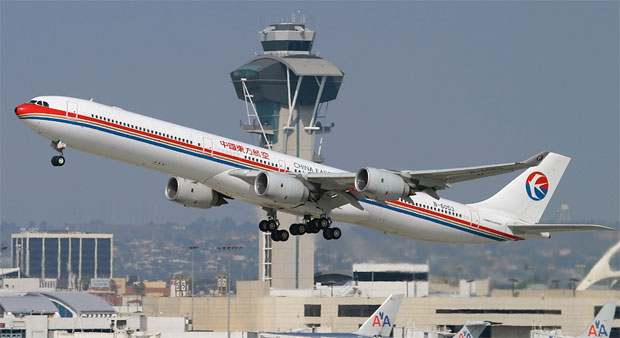
A China Eastern A340-600 lifts off enroute to Beijing. (Photo by Phil Derner)
| Airport use | Open to the public |
|---|---|
| Activation date | 04/1940 |
| Sectional chart | Los Angeles |
| Control tower | Yes |
| ARTCC | Los Angeles Center |
| FSS | Hawthorne Flight Service Station |
| NOTAMs facility | LAX (NOTAM-D service available) |
| Attendance | Continuous |
| Wind indicator | Lighted |
| Segmented circle | No |
| Lights | Dusk-Dawn |
| Beacon | White-green (lighted land airport) |
| Landing fee | No, overnight storage fee |
| Fire and rescue | ARFF index E |
| International operations | Customs landing rights airport |
| See LAX Radio Frequencies |
| Runway 7L/25R | |
|---|---|
| Dimensions | 12091 x 150 ft. / 3685 x 46 m |
| Surface | concrete/concrete/grooved, in good condition |
| Weight bearing capacity | PCN 70 /R/A/W/T |
| Instrument approach | Runway 7L: ILS/DME |
| Runway 25R: ILS/DME | |
| Runway 7R/25L | |
|---|---|
| Dimensions | 11095 x 200 ft. / 3382 x 61 m |
| Surface | concrete/grooved, in good condition |
| Weight bearing capacity | PCN 75 /R/A/W/T |
| Runway edge lights | high intensity |
| Instrument approach | Runway 7R: ILS/DME |
| Runway 25L: ILS/DME | |
| Runway 6R/24L | |
|---|---|
| Dimensions | 10285 x 150 ft. / 3135 x 46 m |
| Surface | concrete/grooved, in good condition |
| Weight bearing capacity | PCN 70 /R/A/W/T |
| Instrument approach | Runway 6R: ILS/DME |
| Runway 24L: ILS/DME | |
| Runway 6L/24R | |
|---|---|
| Dimensions | 8925 x 150 ft. / 2720 x 46 m |
| Weight bearing capacity | PCN 70 /R/A/W/T |
| Instrument approach | Runway 6L: ILS/DME |
| Runway 24R: ILS/DME | |
| Helipad H3 | |
|---|---|
| Dimensions | 63 x 63 ft. / 19 x 19 m |
| Weight bearing capacity | Single wheel: 15.0 |
| Ownership | Publicly-owned |
|---|---|
| Owner | CITY OF LOS ANGELES NO 1 WORLD WAY BOX 92216 LOS ANGELES, CA 90009-2216 Phone 310-646-4265 ARPT OPNS 24 HRS. |
| Manager | JEFF FITCH ONE WORLD WAY LOS ANGELES, CA 90009 Phone 310-646-0157 JEFF FITCH (310) 646-6450. LAX AIRPORT OPERATIONS – RAYMOND JACK (310) 417-0470. |
| Terminal | Airlines |
| Tom Bradley International Terminal | Aeroflot, Air Pacific, Air Tahiti Nui, Alaska Airlines, ANA, Asiana, British Airways, Cathay Pacific, China Airlines, China Eastern, China Southern, Copa, El Al, Emirates, EVA, Japan Airlines JAL, Korean Air, LAN, Lufthansa, Malaysia, Mexicana, Philippine, Qantas, Singapore, Swiss, Thai |
|---|---|
| Terminals 1 | Southwest, US Airways |
| Terminal 2 | Air Canada, Air Canada Jazz, Air China, Air France, Air New Zealand, Aviacsa, Hawaiian, KLM, LACSA, Northwest/Delta, Sun Country, TACA, Virgin Atlantic, Volaris, West Jet |
| Terminal 3 | Alaska Airlines, Horizon, V Australia, Virgin America |
| Terminal 4 | American Airlines, American Eagle, Midwest, Qantas |
| Terminal 5 | Aeromexico, Delta/Northwest |
| Terminal 6 | AirTran, Allegiant, Continental, Copa, Frontier, JetBlue, Spirit |
| Terminal 7 and 8 | United, United Express |
| Aeroflot | 767-300ER |
|---|---|
| AeroMexico | 737-800 |
| Air Canada | A319, E190 |
| Air China | 747-400 |
| Air France | 777-200ER, 777-300ER |
| Air India | 777-200LR |
| Air New Zealand | 747-400, 777-200ER |
| Air Pacific | 747-400 |
| Air Tahiti Nui | A340-300 |
| AirTran | 717, 737-700 |
| Alaska/Horizon | 737-400, 737-800, Dash 8-Q400 |
| Allegiant | MD-83, MD-87 |
| American | 737-800, 757-200, 767-200, 767-300, 777-200ER, MD-80 |
| American Eagle | EMB-135/145 |
| ANA | 777-300ER |
| Asiana | 777-200ER |
| British Airways | 747-400 |
| Cathay Pacific | 747-400, 777-300ER |
| China Eastern | A340-600 |
| Continental | 737-300, 737-800, 737-900, 757-200, 757-300 |
| Copa | 737-800 |
| Delta/Northwest | A320, 737-700, 737-800, 757-200, 757-300, 767-200, 767-200ER, 767-300ER, 767-400ER, 777-200ER, 777-200LR, DC-9, E170, MD-80, CRJ-200, CRJ-700, CRJ-900 |
| El Al | 777-200ER |
| Emirates | 777-200LR |
| Etihad | A340-500 |
| EVA | 777-300ER |
| Frontier | A319 |
| Hawaiian | 767-300ER/td> |
| Japan Airlines | 747-400, 777-200ER |
| JetBlue | A320 |
| KLM | 747-400 |
| Korean | 747-400, 777-200ER |
| LAN | 767-300ER |
| Lufthansa | 747-400 |
| Malaysia | 747-400, 777-200ER |
| Mexicana | A319, A320 |
| Midwest | 717, E190 |
| Philippine | 747-400 |
| Qantas | A380-800, 747-400ER |
| Qatar | 777-300ER |
| Singapore | A340-500, 747-400 |
| South African | A340-300 |
| Southwest | 737-300, 737-700 |
| Sun Country | 737-800 |
| Swiss | A340-300 |
| TACA | A320, A321 |
| United Airlines | 747-400, 757-200, 777-200ER |
| United Express | CRJ-700 |
| US Airways | A319, A320, A321, 737-300, 757-200, CRJ-200 |
| Virgin America | A319, A320 |
| V Australia | 777-300ER |
| Virgin Atlantic | A340-600, 747-400 |
| Volaris | A319, A320 |
| CARGO CARRIERS | |
| Asiana | 747-400F |
| EVA | 747-400F |
| Evergreen | 747-200F |
| FedEx | DC-10F |
| Kalitta | 747-200, 747-400 |
| UPS | 767-200F, 747-400F |
LAX Live Traffic |
LAX Sectional Chart |
| Los Angeles International Airport (IATA: LAX, ICAO: KLAX, FAA LID: LAX) is the primary airport serving Los Angeles, California, the second-most populated metropolitan area of the United States. It is often referred to by its airport code LAX, with the letters usually pronounced individually (IPA: /ɛl.eɪ.ɛks/). LAX is located in southwestern Los Angeles in the neighborhood of Westchester, 16 mi (26 km) from the downtown core.
With 59,542,151 passengers[2] in 2009, LAX is the seventh busiest airport in the world and is served by direct flights to North America, Latin America, Europe, Asia, Oceania, and the Middle East. The airport is a major hub for both United Airlines and Alaska Airlines, a focus city for American Airlines, Southwest Airlines, Allegiant Air and Virgin America. It also serves as an international gateway for Delta Air Lines. The airport also functions as joint civil-military facility, providing a base for the United States Coast Guard and its Coast Guard Air Station Los Angeles facility, operating 4 HH-65 Dolphin helicopters. LAX is the busiest airport in California in terms of flight operations, passenger traffic and air cargo activity, followed by San Francisco International Airport (SFO). LAX is also the only U.S. airport to serve 3 or more international destinations with ridership of 1 million passengers or more per year (Tokyo-Narita, London-Heathrow, Taipei). Although LAX is the busiest airport in the Greater Los Angeles Area, the region relies on a multiple airport system because of its vast size. Many of the area’s most well-known attractions are closer to alternative airports than to LAX; for example, Hollywood and Griffith Park are closer to Bob Hope Airport in Burbank; while John Wayne Airport in Orange County is close to Disneyland, the Honda Center, Angel Stadium of Anaheim, and other Orange County attractions. Long Beach Airport is close to some of the coastal attractions known to Southern California, like Palos Verdes and Huntington Beach. LA/Ontario International Airport is closer to the Inland Empire region’s cities of Riverside, and San Bernardino of Southern California. |
This page contains excerpts of Wikipedia entry Los Angeles International Airport, shared under the GNU Free Documentation License. |


